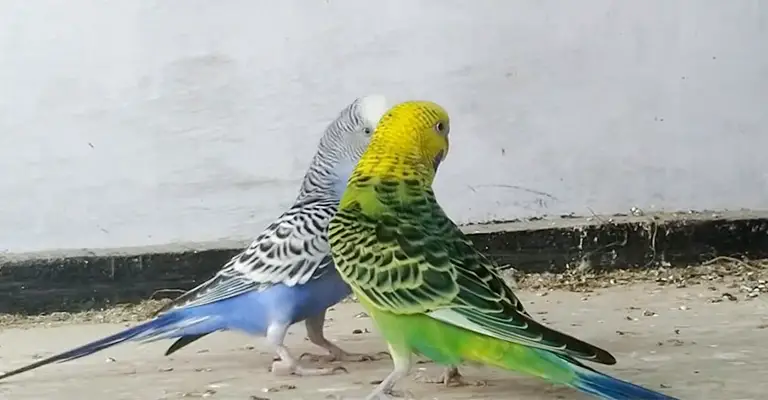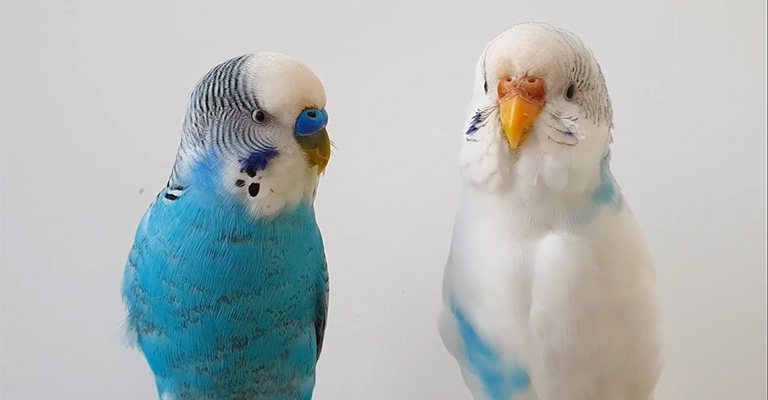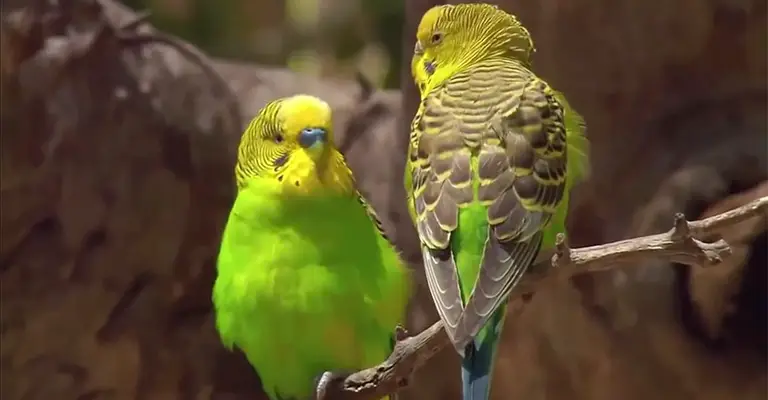The world of avian behaviour offers fascinating insights into the complex dynamics of bird interactions.
Among these, the courtship and mating behaviours of budgies, also known as budgerigars, hold a special place.
Yet, when a male budgie fails to exhibit the expected mating behaviour of mounting a female counterpart, it can spark curiosity and concern among bird enthusiasts.
This intriguing phenomenon raises questions about the intricacies of budgie courtship, individual differences, and the factors that might be at play.
Exploring why does my male budgie not mount the female unveils a deeper understanding of the avian world’s subtleties and the various reasons that could contribute to a male budgie’s reluctance to engage in such behaviour.

Why Does My Male Budgie Not Mount The Female?
There are many possible reasons why your male budgie may not mount the female. Here are some of the common ones:
Maturity Levels:
If your male budgie is not mounting the female, it could be due to differing levels of maturity. Sexual behaviour often emerges when both birds are sexually mature, and if the male is not yet at that stage, he might not exhibit mounting behaviour.
Lack of Bonding
Successful mating often requires a strong bond between the birds. If the male and female budgies have not established a deep connection, the male might not attempt to mount the female.
Health Concerns
Physical health issues, such as pain, injury, or illness, can deter the male budgie from engaging in mating behaviours. Discomfort might lead him to avoid mounting.
Environmental Stress
Stressors like a noisy or busy environment can discourage mating behaviours. If the birds do not feel secure in their surroundings, the male might refrain from attempting to mount the female.
Incompatible Pairing

Budgies have distinct personalities, and not all pairs are compatible for mating. If the birds do not get along well or have clashing temperaments, mating behaviours might not occur.
Lack of Nesting Space
A suitable nesting area is crucial for budgie mating behaviours. If the cage does not have a comfortable, private spot for nesting, the male might not show interest in mounting the female.
Seasonal Changes
Budgies’ mating behaviours can be influenced by seasonal changes and lighting conditions. If the lighting and temperature are not conducive to breeding, the male might not engage in mounting.
Territorial Aggression
In some cases, territorial aggression can deter mating behaviour. If the male perceives the female as a threat to his territory, he might not attempt to mate.
Social Hierarchy
Budgies have social hierarchies, and if the male does not feel dominant or secure in his position, he might not display mating behaviours towards the female.
Observing the birds’ interactions and consulting with an avian veterinarian can help identify the underlying reason for the lack of mounting behaviour.
It’s important to ensure that both birds are healthy and comfortable and have an environment conducive to breeding if you’re planning to encourage mating behaviours.
How Long Does It Take For A Male And Female Budgie To Bond?

The time it takes for a male and female budgie to bond can vary based on several factors. The bond between budgies develops gradually and depends on individual personalities and circumstances.
Here are some important factors that influence the bonding process:
Personality Compatibility
The personalities of the male and female budgies play a significant role in bonding. If their temperaments are compatible, they are more likely to form a strong bond faster. Social and friendly budgies tend to bond more quickly than shy or aggressive ones.
Age and Maturity
The age and maturity of the budgies can influence how quickly they bond. Younger budgies might bond faster since they are more adaptable and open to new social interactions. Mature budgies might take longer to adjust to a new companion.
Shared Space and Interaction
Placing the budgies in the same cage or aviary encourages interaction and bonding. Spending time together in a shared space allows them to get accustomed to each other’s presence, fostering a bond over time.
Proximity and Observation
Keeping the male and female budgies within sight of each other, even if they are in separate cages initially, can accelerate the bonding process.
They can observe each other’s behaviours, vocalizations, and movements, gradually developing familiarity and comfort.
Patience and Interaction
Regular interaction with both budgies is crucial. Spend time talking to them, offering treats, and providing activities that engage both birds.
Gradually introduce activities like eating together, which can strengthen their bond through shared experiences.
It’s important to note that the bonding process is not uniform, and individual budgies might take different amounts of time to form a strong bond. Factors such as past experiences, socialization, and the overall environment also contribute.
As the bond develops, you’ll observe behaviours like preening each other, sharing food, and vocalizing together.
Patience, consistent interaction, and a conducive environment are key to helping male and female budgies establish a meaningful and lasting bond.
How to Encourage Budgies to Breed?

If you want to encourage your budgies to breed, you need to provide them with the right conditions and environment.
Here are some tips that can help you:
Provide A Suitable Nesting Box
Budgies need a cosy and secure place to lay their eggs and raise their chicks. You can buy a ready-made nesting box or make one yourself from a wooden or cardboard box.
The nesting box should have a hole for the budgies to enter and exit, a perch for them to land on, and some bedding material such as wood shavings or shredded paper for them to nest on.
Provide A Balanced And Nutritious Diet
Budgies need a healthy and varied diet to be in good shape for breeding. You can feed them a mix of seeds, pellets, fresh fruits, vegetables, and sprouted seeds.
You can also provide them with some calcium supplements such as cuttlebone, mineral block, or eggshell to help them produce strong eggs and bones.
You should avoid feeding them foods that are high in fat, salt, sugar, or caffeine, such as chocolate, avocado, onion, garlic, alcohol, or coffee.
Provide Enough Light And Warmth
Budgies are more likely to breed when the days are longer and warmer, as this mimics their natural breeding season in Australia.
You can use artificial lighting to extend the daylight hours for your budgies, but make sure to turn it off at night to give them enough rest.
You can also use a heater or a lamp to keep the temperature in the cage comfortable for your budgies, but make sure not to overheat them or expose them to direct heat.
Provide Enough Space And Privacy
Budgies need enough space and privacy to feel comfortable and relaxed for breeding. You should have a large cage that can accommodate the nesting box and the budgies’ activities.
You should also avoid overcrowding the cage with too many budgies or other pets, as this can cause stress and aggression among them.
Provide Some Stimulating Toys And Accessories
Budgies are very playful and curious birds that need some stimulation and enrichment to keep them happy and entertained.
You can provide them with some toys and accessories that can spark their interest and encourage their natural behaviours. For example, you can give them some mirrors, bells, swings, ladders, ropes, balls, or chew toys that they can play with and explore.
Provide Some Hormonal Triggers
Budgies are influenced by some hormonal triggers that can stimulate their breeding instincts. For example, you can expose them to some sounds that mimic the sounds of other budgies mating or chicks begging for food.
You can also expose them to some scents that mimic the scents of other budgies’ hormones or pheromones.
Provide Some Compatible Partners
Budgies are more likely to breed if they have some compatible partners that they can choose from.
You can introduce some potential mates for your budgies by placing them in separate cages next to each other and letting them see and hear each other.
Provide Some Positive Reinforcement
Budgies are more likely to breed if they receive some positive reinforcement from you for their breeding behaviours. You can praise them verbally or give them some treats when they show any signs of courtship or mating.
You can also reward them with some extra attention or affection when they lay eggs or hatch chicks. You should avoid punishing them or scolding them for their breeding behaviours, as this can discourage them or make them fearful of you.
Provide Some Patience And Care
Budgies are not machines that can breed on command or on schedule. They have their own personalities and preferences that can affect their breeding readiness and success.
You should respect their individuality and let them breed at their own pace and comfort level.
FAQ
Several factors could be at play, such as their maturity levels, health issues, compatibility, and environmental stressors.
Each bird’s behaviour is unique, and a combination of these factors might influence mating behaviours.
Yes, physical discomfort due to injury or illness can discourage mating behaviour. If your male budgie is showing signs of sickness, consult a vet to rule out any health concerns.
Yes, environmental stressors like noise, changes in surroundings, or lack of privacy can hinder mating behaviours. Providing a comfortable, quiet space can help encourage natural behaviours.
Absolutely. Just like people, budgies have varying personalities. Some pairs may not get along well, leading to a lack of mating behaviours. Monitoring their interactions can help you gauge their compatibility.
Bonding and mating can take time. Observe their interactions over a few weeks, ensuring their health, providing a suitable environment, and allowing them to establish a connection before considering intervention.
Conclusion
The intricate dance of courtship and mating behaviours in budgies encompasses a myriad of elements that extend beyond the surface.
As we conclude our exploration into the question of why a male budgie might not mount a female, it becomes evident that avian interactions are influenced by a web of factors.
From individual personalities and environmental conditions to health considerations and social dynamics, the complexities at play provide a reminder that every bird—like every individual—possesses its own unique traits and responses.
Through this journey, we gain not only a deeper appreciation for the intricacies of nature but also a reminder that within every seemingly simple interaction lies a tapestry of complexities waiting to be unravelled.